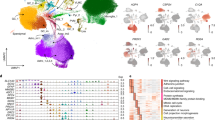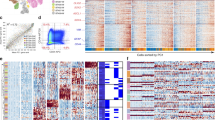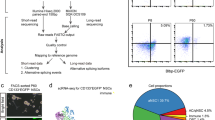Abstract
The study of neural stem cell biology is hindered by the absence of well-defined markers for neural stem cells and neuronal progenitors. Without the ability to identify the relevant cell types, the analysis of how the diverse cell populations of the central nervous system are generated becomes virtually impossible.
This is a preview of subscription content, access via your institution
Access options
Subscribe to this journal
Receive 12 print issues and online access
$189.00 per year
only $15.75 per issue
Buy this article
- Purchase on Springer Link
- Instant access to full article PDF
Prices may be subject to local taxes which are calculated during checkout


Similar content being viewed by others
References
Raff, M. C. et al. Galactocerebroside is a specific cell-surface antigenic marker for oligodendrocytes in culture. Nature 274, 813–816 (1978).
Geisert, E. E. Jr., & Frankfurter, A. The neuronal response to injury as visualized by immunostaining of class III β-tubulin in the rat. Neurosci. Lett. 102, 137–141 (1989).
Zhang, S.-C. Defining glial cells during CNS development. Nature Rev. Neurosci. 2, 840–843 (2001).
Lendahl, U., Zimmerman, L. B. & McKay, R. D. CNS stem cells express a new class of intermediate filament protein. Cell 60, 585–595 (1990).
Clarke, S. R., Shetty, A. K., Bradley, J. L. & Turner, D. A. Reactive astrocytes express the embryonic intermediate neurofilament nestin. Neuroreport 5, 1885–1888 (1994).
Sejersen, T. & Lendahl, U. Transient expression of the intermediate filament nestin during skeletal muscle development. J. Cell Sci. 106, 1291–1300 (1993).
Reynolds, B. A. & Weiss, S. Generation of neurons and astrocytes from isolated cells of the adult mammalian central nervous system. Science 255, 1707–1710 (1992).
Reynolds, B. A. & Weiss, S. Clonal and population analyses demonstrate that an EGF-responsive mammalian embryonic CNS precursor is a stem cell. Dev. Biol. 175, 1–13 (1996).
Vescovi, A. L., Reynolds, B. A., Fraser, D. D. & Weiss, S. bFGF regulates the proliferative fate of unipotent (neuronal) and bipotent (neuronal/astroglial) EGF-generated CNS progenitor cells. Neuron 11, 951–966 (1993).
Ciccolini, F. & Svendsen, C. N. Fibroblast growth factor 2 (FGF-2) promotes acquisition of epidermal growth factor (EGF) responsiveness in mouse striatal precursor cells: identification of neural precursors responding to both EGF and FGF-2. J. Neurosci. 18, 7869–7880 (1998).
Okabe, S., Forsberg-Nilsson, K., Spiro, A. C., Segal, M. & McKay, R. D. Development of neuronal precursor cells and functional postmitotic neurons from embryonic stem cells in vitro. Mech. Dev. 59, 89–102 (1996).
Tropepe, V. et al. Direct neural fate specification from embryonic stem cells: a primitive mammalian neural stem cell stage acquired through a default mechanism. Neuron 30, 65–78 (2001).
Tropepe, V. et al. Distinct neural stem cells proliferate in response to EGF and FGF in the developing mouse telencephalon. Dev. Biol. 208, 166–188 (1999).
Qian, X. et al. Timing of CNS cell generation: a programmed sequence of neuron and glial cell production from isolated murine cortical stem cells. Neuron 28, 69–80 (2000).
Gage, F. H. et al. Survival and differentiation of adult neuronal progenitor cells transplanted to the adult brain. Proc. Natl Acad. Sci. USA 92, 11879–11883 (1995).
Parent, J. M. et al. Dentate granule cell neurogenesis is increased by seizures and contributes to aberrant network reorganization in the adult rat hippocampus. J. Neurosci. 17, 3727–3738 (1997).
Kempermann, G., Kuhn, H. G. & Gage, F. H. Experience-induced neurogenesis in the senescent dentate gyrus. J. Neurosci. 18, 3206–3212 (1998).
Laywell, E. D., Rakic, P., Kukekov, V. G., Holland, E. C. & Steindler, D. A. Identification of a multipotent astrocytic stem cell in the immature and adult mouse brain. Proc. Natl Acad. Sci. USA 97, 13883–13888 (2000).
Doetsch, F., Caille, I., Lim, D. A., Garcia-Verdugo, J. M. & Alvarez-Buylla, A. Subventricular zone astrocytes are neural stem cells in the adult mammalian brain. Cell 97, 703–716 (1999).
Johansson, C. B. et al. Identification of a neural stem cell in the adult mammalian central nervous system. Cell 96, 25–34 (1999).
Kondo, T. & Raff, M. Oligodendrocyte precursor cells reprogrammed to become multipotential CNS stem cells. Science 289, 1754–1757 (2000).
Mezey, E., Chandross, K. J., Harta, G., Maki, R. A. & McKercher, S. R. Turning blood into brain: cells bearing neuronal antigens generated in vivo from bone marrow. Science 290, 1779–1782 (2000).
Brazelton, T. R., Rossi, F. M., Keshet, G. I. & Blau, H. M. From marrow to brain: expression of neuronal phenotypes in adult mice. Science 290, 1775–1779 (2000).
Luo, Z. & Geschwind, D. H. Microarray applications in neuroscience. Neurobiol. Dis. 8, 183–193 (2001).
Luo, L. et al. Gene expression profiles of laser-captured adjacent neuronal subtypes. Nature Med. 5, 117–122 (1999).
Gall, C. M. Regulation of brain neurotrophin expression by physiological activity. Trends Pharmacol. Sci. 13, 401–403 (1992).
Vician, L. et al. Synaptotagmin IV is an immediate early gene induced by depolarization in PC12 cells and in brain. Proc. Natl Acad. Sci. USA 92, 2164–2168 (1995).
Vician, L., Basconcillo, R. & Herschman, H. R. Identification of genes preferentially induced by nerve growth factor versus epidermal growth factor in PC12 pheochromocytoma cells by means of representational difference analysis. J. Neurosci. Res. 50, 32–43 (1997).
Terskikh, A. V. et al. From hematopoiesis to neuropoiesis: evidence of overlapping genetic programs. Proc. Natl Acad. Sci. USA 98, 7934–7939 (2001).
Geschwind, D. H. et al. A genetic analysis of neural progenitor differentiation. Neuron 29, 325–339 (2001).
Uchida, N. et al. Direct isolation of human central nervous system stem cells. Proc. Natl Acad. Sci. USA 97, 14720–14725 (2000).
Rietze, R. L. et al. Purification of a pluripotent neural stem cell from the adult mouse brain. Nature 412, 736–739 (2001).
Keyoung, H. M. et al. High-yield selection and extraction of two promoter-defined phenotypes of neural stem cells from the fetal human brain. Nature Biotechnol. 19, 843–850 (2001).
Tyagi, S. & Kramer, F. R. Molecular beacons: probes that fluoresce upon hybridization. Nature Biotechnol. 14, 303–308 (1996).
Acknowledgements
The authors are suppoted by the US National Institute of Mental Health. We thank M. Easterday for helpful comments.
Author information
Authors and Affiliations
Corresponding author
Rights and permissions
About this article
Cite this article
Kornblum, H., Geschwind, D. Molecular markers in CNS stem cell research: hitting a moving target. Nat Rev Neurosci 2, 843–846 (2001). https://doi.org/10.1038/35097597
Issue Date:
DOI: https://doi.org/10.1038/35097597
This article is cited by
-
Human brain metastatic stroma attracts breast cancer cells via chemokines CXCL16 and CXCL12
npj Breast Cancer (2017)
-
Growth hormone responsive neural precursor cells reside within the adult mammalian brain
Scientific Reports (2012)
-
Regulatory networks define phenotypic classes of human stem cell lines
Nature (2008)
-
Neural stem cell therapy for neurological diseases: dreams and reality
Nature Reviews Neuroscience (2002)
-
Neural induction, the default model and embryonic stem cells
Nature Reviews Neuroscience (2002)



